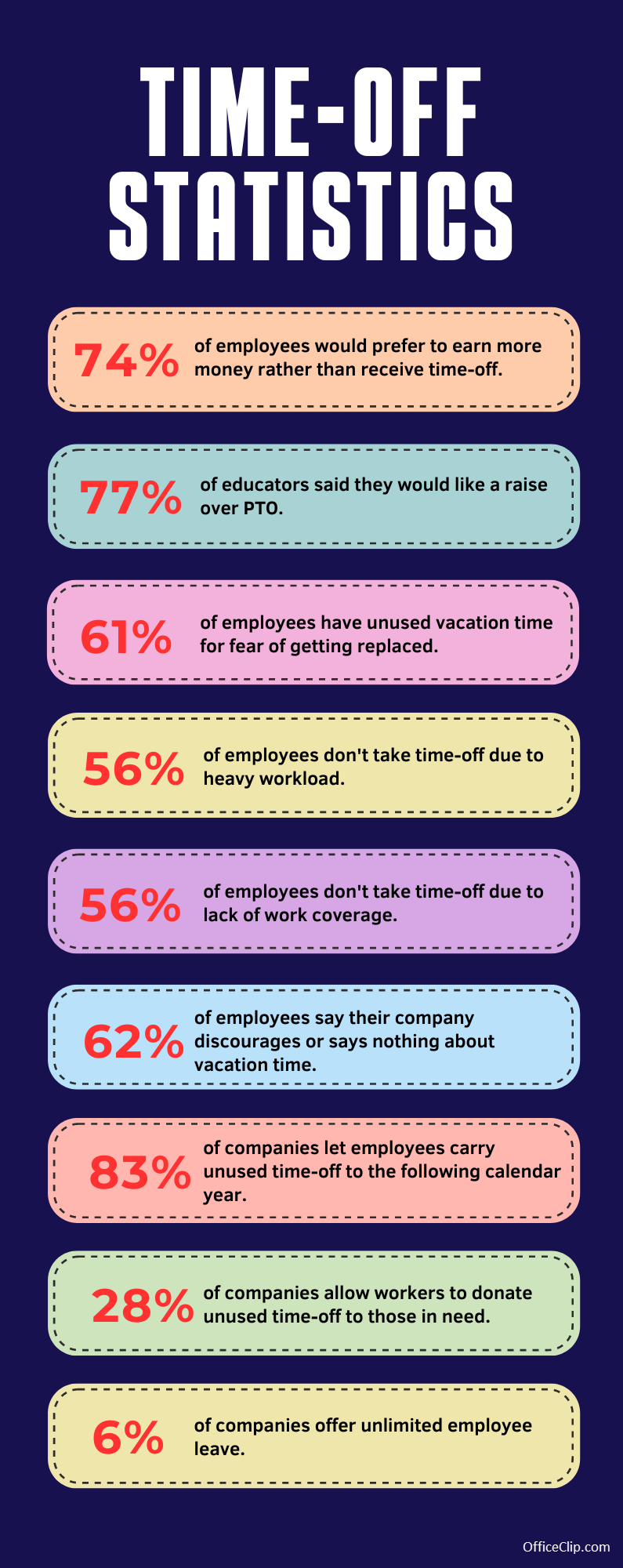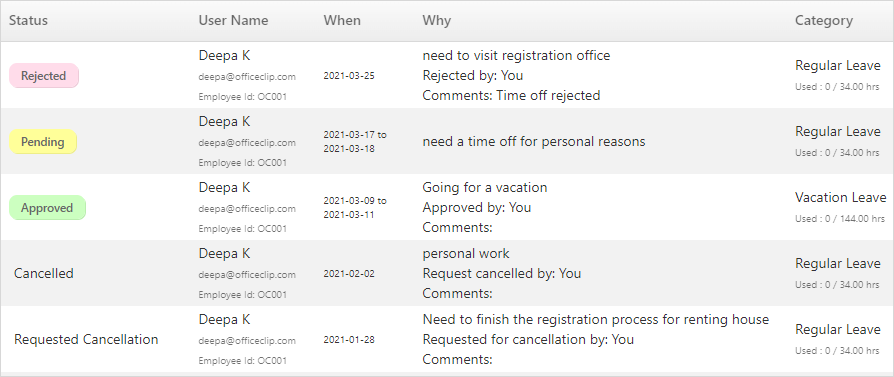Introduction:
“Some of your best ideas come when you’re on vacation.”
– Gautam Singhania, CEO, Raymonds Group
Generous leave policies are a valuable asset for businesses of all sizes.
Studies have shown that employees with generous leave policies are more likely to be physically and mentally healthy. This is because they have the time to rest and recover from illness or injury, and they can also take time off to care for their families or to deal with personal matters.
Healthy employees are more productive. They are more likely to be focused and engaged at work and less likely to make mistakes. This can lead to increased profits for businesses.
In addition to the health benefits, generous leave policies can help improve employee morale. Employees who feel valued by their employers are likelier to be happy and productive, leading to a more positive work environment.
Table of Contents:
- What is a Paid Time-Off?
- Are Time-Offs Beneficial for the Company?
- Types of Paid Time-Offs
- PTO Calculations
- Paid Time-Off Statistics
- Local Laws
- Paid time-off policies in different countries
- How to design a PTO policy?
- Paid Time-Off Templates
- Limitations of using a Template
- Advantages of using a PTO software
- How OfficeClip Time-Off software simplifies time-off tracking?
- How to encourage your employees to take Time-Off?
- Conclusion
What is a Paid Time off?
Paid time off is a benefit provided by the company, where a pool of leaves is sanctioned for the employees, and above all they receive compensation while away from work.

Employees can take these leaves during any period within a year. These leaves are bundled in different categories and depends on their years of service. For example, a new employee may accrue ten days of PTO per year, while a senior employee may accrue 20 days of PTO per year.
PTO can be taken in a variety of ways. Employees can take a single long block of time off or several shorter blocks of time off.
Good PTO policies can help attract and retain top talent. Employees who feel valued by their employer and have the flexibility to take time off when needed are more likely to be productive at work.
Time Off: A Win-Win for Companies and Employees:
Giving time-offs is a win-win situation for both employees and the company. While it is an additional financial burden for the company, but it comes with its benefits.
5 ways Time-Off can benefit your Company:
- Reduced unscheduled absenteeism: Planned time off allows employers to make prior arrangements and avoid disruptions to work.
- Increased employee satisfaction: Good time off policies are seen as a reward to employees, which can help retain current staff and attract new talent.
- Reduced employee burnout: Time off can help reduce employee burnout, a significant cause of decreased productivity.
- Attraction of top talent: Attractive PTO benefits can give businesses an edge over competitors and attract the best talent in the industry.
- Increased productivity, focus, and creativity: Vacations can refresh employees, who will return to work with increased productivity, focus, and creativity.
How Time-Off benefits Employees?
- With different leave policies employees can take time off as needed without having to provide excuses.
- Employees can use time off to spend with their loved ones, travel, pursue hobbies, or relax without affecting their pay.
- Apart from their monthly salary, this is like an additional monetary benefit an employee receives in the form of time off.
- With fresh minds, people tend to organize things better, which helps create a work-life balance.
- A stressful workplace will create an impact on physical as well as mental health. Physical stress leads to various diseases like blood pressure, obesity, and heart-related illness, consequently mental exhaustion will lead to depression, low self-esteem, and reduced performance. Taking time off will improve physical and mental health and increase motivation to work.
Different types of Paid Time-Off:
Sick Leave:
It is the leave granted for medical reasons. Employees can avail time off if they have to undergo surgery or have some injury. If the number of days for sick leave increases, the employee may have to present the medical certificates to the company as proof.
Vacation Leave:
Gives a break from a busy schedule. The employees can spend time with family and friends, go on a vacation, or travel.
Personal Leave:
This leaves employees can take for some personal reasons. This leave can include a short term, where an employee may want to take a break for only 4-5 hours to visit a doctor’s clinic, government office, or attend some events.
Parental Leave:
This leave may include maternity leave, paternity leave, or leave for adoption. Not only a specific number of days are allotted for parental leave, but also the employee can extend it if they prefer to take a leave for a longer duration.
Bereavement Leave:
Leave taken in case of the death of a relative or a family member.
Holidays:
These are the holidays earned by the employees, followed by the federal holiday schedule. These holidays include Thanksgiving, Christmas Day, Labor Day, Independence Day, Memorial Day, etc.
Military Leave:
If an employee is required to serve for active duty, active duty training, or inactive duty training, they can avail themselves of military leave and get paid.
Sabbatical Leave:
For this type of leave, the employers allow employees to pursue further education, do any research or pursue any hobby. This leave may last up to 6 months to one year.
Leave for Voting:
Often, employees are granted leave for specific hours to cast their vote during the election. As per the study, 44% of employers give time offs for voting purposes.
Leave of Absence:
These leaves are mostly granted if all your paid time off is exhausted. Employers can grant this leave, however they will be without pay.
How to calculate Paid Time Off?
Example:
Dan is a salaried employee who accrues two days of casual monthly leave for 24 days per year.
Dan has used six PTO days this year and accrued 18 days. Depending on company policy, these 18 days may be carried over to the following year or paid out to Dan in cash.
Suppose we consider that Dan earns $200 per day. Total time offs remaining are 18, so the total compensation for the time offs will be 18 days X $200 = $3,600 before paying taxes.
PTO Calculations:
PTO calculations can be done for different periods as some employees are paid –
- Hourly
- Daily
- Weekly
- Monthly
- Bi-Monthly
Before you calculate, you need to decide how many hours your employees will accrue. Accruals also differ from employee to employee. It often depends on the years of service in the organization.
We are providing a simple example to give you an overview of how to calculate accrued time offs per hour:
If you give your employees a time off of 3 weeks, that will approximately be 120 hours (considering 8 hours per day for 5 days a week).
There are 52 weeks in a year and one week consists of 40 hours of work.
So a year consists of 52 weeks X 40 hours = 2080 working hours.
Subtract the time off hours from working hours:
2080 work hours – 120 PTO hours = 1960 of work hours remaining.
So the employee would work 1960 hours per year with full pay.
To find the accrual rate per hour, we divide time off hours by work hours, i.e., 120/1960 = 0.06.
So the employee accrues 0.06 hr of time offs for every hour they work.
Their accrual calculation will be:
| Per Hour: 0.06 hours Per day: 0.06 X 8 hours = 0.48 hours Weekly: 0.06 X 40 hours = 2.4 hours Semi-monthly: 0.06 X 80 hours = 4.8 hours Monthly: 0.06 X 160 hours = 9.6 hours Yearly: 0.06 X 2080 = 124.8 hours |
This calculation you can set in your time off software system and calculate yearly accruals for employees.
Similarly, you can calculate accruals for different employees working hourly, daily, weekly, monthly, or bi-monthly.
Paid Time-Off Statistics:

Statistics on Importance of Time Off:
| Bosses agree that vacation improves an employee’s focus (78 percent) and alleviates burnout (81 percent). | |
| The highest income earners, those earning more than $150,000 annually, took an average of 22.5 days and left only 3.1 days on the table. | |
| Employees who reported that their company encourages vacation (68 percent) are much happier with their jobs than those who work at places(They are also more likely to use all of their vacation time) | |
| The 10% of employees who reported taking a workcation (proactive decision to travel somewhere with the intent to work a regular schedule remotely) report a much stronger affinity for the idea. | |
| For 58% employees it has increased their physical and mental wellbeing. |
Local Laws:
Can paid time off be denied?
In the United States, employers can deny most time-offs unless they are mandated by law or specified under the company policy.
If the employee is sick and has some medical condition, the company cannot deny time offs. But they can refuse personal time off if there are targets to be completed or if any time off clashes with another person’s time off. So it is always better to plan and discuss before taking any time off to avoid any conflicts.
It is always essential that the employees understand and read the PTO policies designed by the company carefully to avoid any confusion.
For example, during Covid, the Healthcare workers had a tough time taking time offs due to increased work pressure and an increasing number of patients.
The hospitality industry rarely allows its employees to take time offs during weekends, special holidays, or during the special seasons.
But if an employee requests time off under CFRA or FMLA for a reason covered by the law, the employer cannot legally deny the employee’s request for time off.
Do part-time employees get a PTO?
There are no state or federal laws that require employers to provide a vacation to part-time employees.
Employees who do not have regularly scheduled work hours are not entitled to get paid time off. But if the part-time employees have a regular schedule, work schedule, and non-scheduled non-overtime hours on holiday, they are entitled to holiday pay for all scheduled hours worked.
It is also up to the employers to decide, based on their budgets, whether to give paid vacation to part-time employees.
Is there any difference between Personal Time Off and Paid Time Off?
Personal time offs are a part of Paid time offs. These are usually taken for medical appointments or emergencies in the family, or you may have to visit your child’s school for a meeting or any other recreational activity.
Time-Off policies in different countries:
Every country has different time-off policies . In the USA, workers are entitled to 12 weeks of unpaid vacation via the FMLA, but no federal law regulates paid leave. It is the only country with no minimum paid vacation.
According to the US Bureau of Labor Statistics, 77% of private employers offer paid time off to their employees.
The average PTOs offered are:
- 10 days after 1 year of service
- 15 days after 5 years of service
- 17 days after 10 years of service
- 20 days after 20 years of service
Some countries have the best time off policies, while others have the worst. The following article will give an overview of time off policies indifferent countries:
Paid Time-Off policies in different Countries
How to design a PTO policy?
The key considerations for designing a PTO policy
Leave Categories:
The management needs to decide:
- Which leave categories they want to create?
- What is the number of time offs to be given under each category?
- What will be the number of time offs given to employees for each designation?
- Will Accruals be calculated for all leave categories?
- Should weekends be considered as time off?
- Which leave categories will be paid and which ones will be unpaid?
- If a new employee is joining in, from which date they will be eligible for taking time offs?
Accruals:
The things to be considered while creating accruals are:
- Which leave categories will have accruals?
- Fix accrual hours for all employees ranging from new joiners to seniors or fix as per designation.
- Fix the period of accrual – whether it should be hourly, daily, weekly, monthly or yearly.
- Whether they can be prorated or not?
- What should be the accrual calculation period – beginning of the year, end of the year, or employee anniversary date?
- What should be the maximum accrual limit?
- If no limit for accruals is set, what will be the number of leaves that will be encashed and how much of them will lapse?
- Are carryovers of accruals allowed? If yes, what should be the limit?
For more detailed information accruals, check the link to below articles:
Adjustments:
Suppose an employee is working overtime or working on weekends. Can they add these additional worked hours in the leave categories to compensate for leave they have taken due to emergencies or some other reason? Which leave categories will be applicable for adding adjustments?
Payment upon termination:
The management needs to decide the policy if an employee is terminated from the service. Then, they can decide as per the laws based in that particular state.
Time Off Approval:
The company needs to decide who is responsible for approving the time offs for employees for different designations.
Procedure:
Plan on how to create a proper procedure for making and approving time-off requests. And also provide clear guidelines to all the employees about the time off policies to avoid confusion and misinterpretation.
Buy or sell PTO:
Can employees buy or sell their PTO weeks? Some companies like Ericsson and American Express do have this option to buy or sell the PTOs.
Apart from this also consider the below points:
- What should be the policy for exempt and non exempt employees?
- Are negative time offs allowed?
- What if an employee quits with a negative time off balance?
- What should be the time frame to request time off?
- How to comply with the state and local requirements?
- Can PTO’s be used for half days?
List of companies having the best PTO policies:
| Company | Time-Offs provided |
| Deloitte | Up to 25 days of PTO. Unused time off can also be accumulated and used for next year. |
| Microsoft | 3 weeks of vacation time, 2 weeks of sick leave, and several floating holidays |
| Intel | 3 to 4 weeks of vacation per year and has a well-paid sabbatical program |
| JP Morgan and Chase | 4 weeks of vacation, 3 personal days, 6 sick days in addition to 9 company holidays |
| American Express | 28 vacation days and can also buy and sell vacation days |
| Accenture | 3 weeks of PTO and carryover of up to 240 hours |
| Capital One | 4 weeks of PTO, and employees can buy an extra week of PTO |
| Progressive | In the first year, up to 3.5 weeks of time off can go up to 8 weeks of PTO, with an extra week of PTO after five years. |
Many companies are also becoming more flexible with work from home policies, and work hours.
For example, an online children clothing retailer Primary has started a four-day work week. Initially they found that endless work hours and home life was taking a toll on their workers. So they shortened the work week and noticed a drastic change in employees’ focus and found increased productivity.
Free Paid Time-Off Templates:
Steps to use time-off request templates:
- Download the Word and Excel time-off request templates.
- Fill-in and submit it to your manager for approval.
- To access online use the Google Sheets and Google Forms.
- Print the PDF format and submit.
- You can print, customize and download these templates.
Limitations of using a time-off template:
- While creating a request for time off, you will have to download and fill up the template manually.
- You will have to either send the template or email it to the manager for approval.
- Every time you will have to call up the manager and find out about the request approval.
- There are chances of the template getting misplaced.
- At the end of the year, it will be difficult for the manager to calculate the total number of time offs taken.
- Using templates will be a big hassle in a large organization as it is challenging to track time-offs for many employees.
- Manual time off and accrual calculations may lead to errors.
How a PTO software can streamline your Leave management?
Keep track of Time Offs:
An efficient time off software will keep track of the time offs of all the employees throughout the year. In addition, the employers will give an overview of the time offs taken under different categories at the end of the year.
Daily, the software will give the manager an idea of who is taking time off and when and make necessary adjustments accordingly.
Accrual Calculations:
Creating accrual policies for different levels will be easy with a proper system. For instance, once each employee’s accrual per hour is calculated, enter it into the system. It will give an idea of the accrual balance, carryovers, and the amount to be encashed to the employees at the end of the year.
View Time-Off balances:
With the software, employees can view the number of time offs allocated to them and the used time off balances in the system and can plan their future time offs accordingly.
Requesting Time-Off and getting approved:
Sending emails for time off to and forth, waiting for approval, and following up with managers every day becomes a hassle and a time-consuming process. However, a proper system makes the time off request and approval process reasonably smooth. With instant notifications, the manager can quickly approve the employee’s time off request, saving time and effort.
Flexibility:
With the number of time offs available under different leave categories, employees will no longer hesitate to take time offs. In addition,they don’t require to provide an explanation or excuse to their managers.
Equality in the allotment:
Once the company fixes leave categories and accrual policies, all employees will be allocated the time off as per their designation. There will be no discrimination on the number of time offs and no chances of favoritism.
Less scope for errors:
An efficient time off system will track all the leaves and accurately show all the PTO balances. The information for all employees in one place will also make accrual calculation easy with no scope for errors.
PTO management made easy with OfficeClip:
With all the essential features, OfficeClip Time Off software will smoothly track all your employees’ time off and accruals.

OfficeClip PTO software will enable you to:
- Create multiple leave categories.
- Depending on your organizational hierarchy, you can create various accrual policies for each category.
- Set the period, amount of accrual, accrual carryover limit, and maximum accrual limit in the system.
- Set users for different accruals.
- Create a workflow for approving time-offs.
- Add Adjustments like overtime or work on weekends.
- View time-off balances.
- Take a glance at the time-off history of all employees in different time-off categories.
- Get an overview of monthly time offs in the OfficeClip calendar and visibility of employee availability.
- Receive notifications for time off requests sent and time offs approved or rejected.
- Create and view Time off reports by time off requested and approved.
OfficeClip Time Off software is available in the Free version and for unlimited users.
How to encourage your employees to take Time- Offs?
- Discuss all the time off policies with your team openly. Make some rules to make a particular category of time off mandatory, so that employees are bound to take holidays.
- Ensure time offs are taken at different intervals and workload is distributed evenly.
- Explain to them the importance of taking vacations, spending time with family, and taking care of physical and mental health. Encourage them to disconnect from work for some period and create a work-life balance.
- For some leave categories, limit the carryover hours, so that the employees either use their time off or will have them lapse.
- Adopt a software where they will be able to easily view their time-off balances to plan their vacations ahead of time.
Conclusion:
Every company can create time off policies taking into consideration their business requirements.
But encouraging employees to take time off will benefit the employees and help the company in the long run with increased productivity and revenue and a happy workforce.
References used:
https://www.zippia.com/advice/pto-statistics
https://www.fool.com/careers/2017/11/20/7-paid-time-off-stats-youll-find-fascinating.html
https://blog.accessperks.com/employee-benefits-perks-statistics#pto
Image Courtesy:
Recommended Articles:
Note: This blog was created in 2022 and has been updated.
Deepa Kapoor is an online writer for small businesses. She loves to write on the advancements of new technologies and how it affects our lives. She always explores ways to make small businesses more profitable. When not writing, she enjoys reading books and cooking exotic traditional food.




